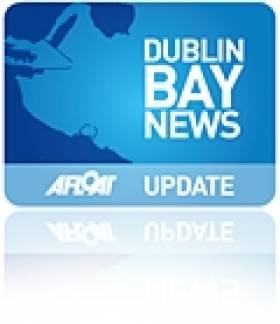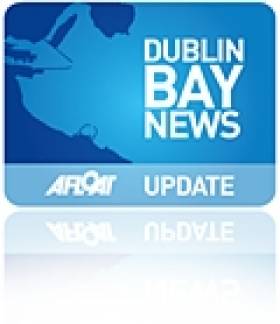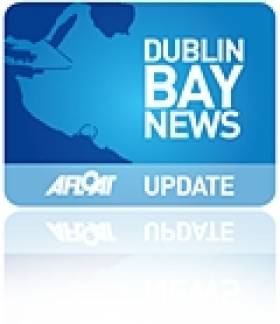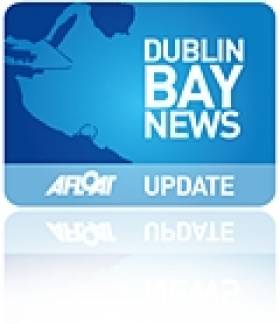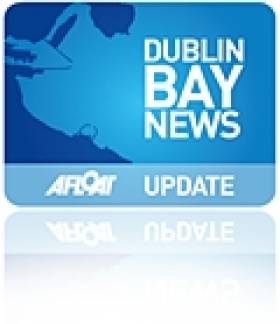Displaying items by tag: Dublin Bay News
#DublinBayCruises – Sailings are underway having started yesterday as Dublin Bay Cruises continue running this weekend as well to 11,12,13 April and a full 7-day schedule will be operating from Good Friday onwards, writes Jehan Ashmore.
The St. Bridget offers five cruise excurision options; Dun Laoghaire Harbour-Dublin City Centre and reverse, Dublin City Centre-Howth and also in reverse as well to Dun Laoghaire Harbour-Killiney Bay cruises that returns to the port which is rail connected by the DART to Dublin.
Check-out below the operators website video of what makes up the life and activities to be seen on and along the coast of Dublin Bay, a natural resource on the doorstep of Dublin City. How many other European capitals can boost such a wonderful amenity?
Watch out for glimpses of seals, the Liffey's National Convention Centre at night, joggers on Dun Laoghaire's East Pier and cyclists along the neighbouring waterfront of Newtownsmith, an artist at Coliemore Harbour Dalkey, the Baily Lighthouse and Ireland’s Eye.
In addition a fleeting shot of a recent visitor to Dublin Port that Afloat.ie reported on of the German Navy oil replenishment tanker Frankfurt auf Main (A1412). The auxiliary oiler replenishment (AOR) tanker had called with frigates as part of a Task Group. The AOR can also handle containers for military equipment, stores and an aft deck for helicopters. So who know’s what boats and ships you may see!
Asides matters marine, there's the variety of marine wildllife and more... all out there in the expanse of the horse-shoe shaped Dublin Bay, ready to be explored and most of enjoyed as a visitor attraction experience!..
Noting that tickets of on all cruises are sold on a single-journey basis and include a voucher that allows each passenger to travel for €2 the same day on any DART train between Dun Laoghaire and Howth or embark at any station along the route.
To book tickets contact 01 90 11 757 or book online and for further details visit: www.dublinbaycruises.com/cruises/
Dublin Bay Cruises Operate for St. Patrick's Weekend
#DublinBay – This St. Patrick' s weekend will see Dublin Bay Cruises running a network of excursions across Dublin Bay linking Dublin city centre with Dun Laoghaire and Howth Harbour's, writes Jehan Ashmore.
The specialised sailings on Saturday, Sunday and the Monday (15,16 and 17 March) are in advance to the excursion operator running regular season sailings which resume on Friday 4 April.
Cruise excursions options are: Dun Laoghaire-Dublin city-centre, Dubin city-centre-Howth Harbour, Howth Harbour-Dublin city centre and the final cruise operated on each day is Dublin city-centre-Dun Laoghaire Harbour. Each of the four excursion ticket prices are for one-way only journeys.
The cruises offer great views across the expanse and beauty of Dublin Bay and notably the coastline along Dalkey to the south and Howth Peninsula to the north.
In addition to calls to the capital via the commercial port as the excursion berth is closer to the city-centre opposite the National Convention centre and where the action of St. Patrick's weekend festivities will be more apparent.
Cruises are operated by the steel-hulled 100 passenger St. Bridget which has a covered lounge area and open deck spaces to take in all the vista's. For more information visit: www.dublinbaycruises.com
Old Gaffers 50th Gathering Celebrations On Display
#Gaffers50th – A collection of sailing images taken by Gillian Mills during the 50th anniversary of the Old Gaffers Association held in Dublin Bay last June will be on display tomorrow in the Poolbeg Boat & Yacht Club, Rinsgend, Dublin.
All are welcome to attend the opening that's starts at 3pm and where the display reflects in the celebration of the gathering gaff-rig craft during the three day event in early summer. The half-centenary event drew craft from throughout Ireland, the UK and further afield.
In addition a variety of other traditional sailing boats attended as previously reported the classic Howth 17's which joined in sailing celebrations and for the inaugural Dublin Port RiverFest held on the Liffey.
So if you are in the area and have 90 minutes to spare, come along to the Poolbeg club located in the heart of the port. For information about the Dublin Bay branch of the OGA visit this website and for the venue visit: www.poolbegmarina.ie
Christmas Cruises Across Dublin Bay
#ChristmasCruise – Take a Christmas Cruise in Dublin Bay this festive season!... with Dublin Bay Cruises operating between Dun Laoghaire Harbour and Dublin City Centre, writes Jehan Ashmore.
The Christmas Cruises includes a complimentary mulled wine served in the heated lounge of the St. Bridget as she sails across Dublin Bay and to and from the Liffey and Dun Laoghaire Harbour.
Christmas Cruises operate every weekend (Saturday and Sunday) until 22 December with convenient locations at both destinations.
The East Pier in Dun Laoghaire Harbour and in Dublin city centre along Sir John Rogersons Quay close to the Samuel Beckett Bridge (Ferryman Bar & Hotel) which is opposite to the Convention Centre.
Christmas Cruise schedule:
10.00 East Pier, Dun Laoghaire to Dublin City Centre arrive 11.15 (one-way)
14.00 Dublin City Centre depart to Dun Laoghaire arrive 15.15 (one-way)
Customers taking the cruise can avail of concession DART tickets.
All infants travelling must be included on your booking. Prices (one way only) are for example: Adults €22 and you can even take your Bicycle for €5. To book call: (01) 90 11 757 or online: www.dublinbaycruises.com/booking
Alternatively take a well earned break on a 75 minute (city-centre to city centre) round-trip cruise departing 12 noon from Sir John Rogersons Quay from within the Docklands, through the port and out into Dublin Bay.
As previously reported earlier this year Dublin Bay Cruises launched Dun Laoghaire-Howth Harbour excursions and they are to resume in April 2014 albeit with the route including an en-route call to Dublin City Centre in both directions.
In addition to running a round-trip Evening Cruise departing Dun Laoghaire Harbour which will incorporate Dalkey Island and Killiney Bay.
Dun Laoghaire Yacht Club Cuts Fee for New Members to €175
#dmyc – The Dun Laoghaire Motor Yacht Club (DMYC) has announced a new introductory membership fee. New members can now join for just €175 and enjoy all the facilities the Club has to offer. This rate will be for 2014, again in 2015 with the full rate of applicable membership (crew, ordinary etc.) applying after the two years. It might be a good way to introduce a friend, family member, business colleague to the water through the DMYC. It might even solve that age-old problem – “what do I get her/him/them for Christmas?”. Contact Karin in the office 01 2801371 or email [email protected].
L.E. Emer Takes Capital Centre-Stage Berth at Flight Fest Feast
#FlightFest – L.E. Emer's (P21) last large-scale public duty in Dublin Port took place at yesterday's Flight Fest flyover spectacular which according to organisers drew around 130,000 spectators, writes Jehan Ashmore.
The Naval Service's eldest fleet member was built by Verolme Cork Dockyard in 1978 and she berthed at North Wall Quay in front of the impressive backdrop of the National Convention Centre.
Tours were available onboard the sell-listed OPV on what would be the last such opportunity during her visit to the capital. Today she resumed her final patrol duties scheduled to end this Friday in Cork Harbour.
Adjoining the Convention Centre is the PWC building which was where a dedicated air-traffic control team placed in charge of the 30 plus aircraft of all shape and sizes that flew low over the length of Dublin Port and 'Docklands' quarter.
As previously reported among the participating aircraft were a pair of Air Corps CASA fishery patrol planes of the maritime squadron which flew in close formation with PC9 aircraft also drawn from the air-wing of the Irish Defence Forces.
As well as the World War II Catalina Flying-Boat with its distinctive design which could be easily identified from quite a distance as she loomed over the Liffey to the crowds delight.
Onlookers not only filled the city-centre quays but also thronged another Irish built vessel, T.S.M.V. Cill Airne which was chartered out for a private function.
The riveted hull veteran represents another rare example of an Irish built ship surviving on our shores. In this case the former Cobh-based transatlantic liner tender was built locally at the Liffey Dockyard more than a decade earlier than the L.E. Emer.
These days Cill Airne has a purely static role as she is moored as a floating river-restaurant, bar and lounge venue which was particularly well patronised during the Flight Fest that saw aviation and shipping converge.
Retiring L.E. Emer to Launch Flight Fest Spectacular Featuring Marine-Related Aircraft
#FlightFest – L.E. Emer (P21) as previously reported will officially launch tomorrow's Flight Fest spectacular above Dublin Port and she will be open to public tours before retiring with less than a week to go, writes Jehan Ashmore.
The eldest member of the Naval Service fleet is berthed at North Wall Quay which is downriver from the Samuel Beckett swing-bridge which will not be accessible for vehicles but kept open to plane-watchers.
Organisers of the festival involving street events starting 12 noon, suggest the best vantage points to view more than 30 aircraft in the flyover (13.50hrs-17.00hrs) are along both sides of the Liffey quays of the city-centre 'Docklands' quarter.
The quays will be pedestrianised between Custom's House Quay to the East Link Toll Bridge on the northside, and from Georges Quay to the end of Sir John Rogerson's Quay on the southside.
The impressive 'Gathering' of aircraft include planes representing each decade stretching back to the 1930' s. They are to be flown at a mere 800 feet (rather than the norm of 1,700 feet) as they approach on a special flight-path corridor than runs on a East-West direction, i.e. from Dublin Bay and over the port entrance and city-centre.
Among the great line up of historic World War II aircraft will be a Catalina flying boat that served from Lough Erne in Co. Fermanagh.
In addition the Aer Corps CASA patrol craft of the Marine Squadron, that monitors fishing vessel activity and where information is relayed to Naval Service headquarters at Haulbowline, Cork Harbour.
The Naval Base is where the L.E. Emer will be arriving next Friday on completion of carrying out her final patrol duties. She is to be de-commissioned and put up for public auction next month.
The FlightFest will also feature the important role of the Irish Coast Guard's life-saving helicopters of the Sikorsky S61 and S92 designs.
For a complete list of the flyover involving aircraft from civil, private and the military and notably the giant Airbus A380 from British Airways, visit this link For general information visit: http://flightfest.ie/faqs
Special Sailing to See Sky Spectacular of Flight Fest Flyover Over Dublin Port
#SeaThePlanes - Dublin Bay Cruises are offering a special sailing up the river Liffey next Sunday (15 Sept.) to view the spectacular Flight Fest flyover of aircraft over Dublin Port, writes Jehan Ashmore.
The sailing departs Howth Harbour at 12.30 pm and sails across Dublin Bay and up through the port as far the East Link Bridge area which will afford an excellent vantage point to view this amazing event.
Aircraft stretching seven decades will be represented as they fly above Dublin Bay before swooping over the port and city-centre at a mere 800 feet in altitude.
A notably Flight Fest flyover participant is the giant A380, the world's largest and latest commercial passenger airliner. The double-deck, wide-body, four-engine jet airliner is to be shown off by British Airways.
As previously reported, wings for the aircraft are constructed in North Wales and transported by ship to France, where the A380 is assembled.
Returning to the special sailing there will be a drinks reception served onboard followed by a seafood platter during the five-hour excursion which will also take in the scenic coastlines of Dublin Bay and Howth Peninsula.
The excursion continues from Dublin Port departing around 17.00hrs and sails to Dun Laoghaire Harbour and to arrive at 17.45 hours where passengers are to disembark.
Cost per person is €60. As places are limited to 99 passengers on board the St. Bridget (1978/100grt) there are no discounts on this special sailing for students/children etc. For further information visit: www.dublinbaycruises.com
Shackleton’s Ships Past & Present and ‘Endurance’ Exhibition
#ShackletonShips – Sir Ernest Shackleton who led the Imperial Trans-Antarctic expedition of 1914-1918 is remembered and honoured in different forms, writes Jehan Ashmore.
Notably, three vessels of which two are named after the Irish-born explorer and the other is named after the ice-trapped exhibition ship, Endurance. The incident of course would result in the remarkable polar rescue mission as previously reported of the compelling exhibition currently on display in Dun Laoghaire.
The present day HMS Endurance (A171) is awaiting a decision on her future as she lies in her home port of Portsmouth, following a near-floundering off Chile in 2008. She had been employed as a hydrographic and support vessel for British Antarctic Survey (BAS), which is responsible for the UK's national scientific activities in Antarctica.
Her successor, RRS Ernest Shackleton, which is primarily a logistic ship is used to re-supply survey stations with occasional science and specialist tasking. Hear and see her ice-strengthened hull crunch through sea-ice with this VIDEO CLIP.
RRS James Clark Ross is her fleetmate and she has some of Britain's most advanced facilities for oceanographic research and is the platform for most marine science undertaken.
During September/October, of each year both vessels registered in Stanley, Falklands Islands, sail from the UK and return the following May/June.
The second 'Shackleton' as previously reported is a Dublin Port Company tug which was named in 2010.
For further information on the Shackleton Endurance Exhibition: 'Triumph Against All Odds' which features stunning photographs taken by expedition team-member Frank Hurley and much more in the Dun Laoghaire Ferry Terminal, visit www.shackletonexhibition.com
Exhibition: Dun Laoghaire & the 1913 Lockout
#1913Lockout – Dun Laoghaire & the 1913 Lockout is the theme of a commemorative exhibition which runs between 22 August-18 January 2014 in the National Maritime Museum of Ireland (NMMI) in Dun Laoghaire.
The exhibition is to feature unique historic photos taken of the period of the harbour town.
Myles Dungan, broadcaster and historian is to open the exhibition on 22nd August at 6.30 p.m. and the evening event will include readings by Martina Devlin and a performance on "Larkin" by Jer O'Leary.
Between 23-25 August, a number of events will take place close to the NMMI, where the maritime museum is run by the Maritime Institute of Ireland.
The events include walking tours, the unveiling of a 1913 Centenary Plaque, a round table discussion organised by Heritage Ireland and a series of lectures.
For more information on these events contact the organisers: Dun Laoghaire 1913 Commemorative Committee by emailing: [email protected] For more information and about the museum visit: www.mariner.ie


























